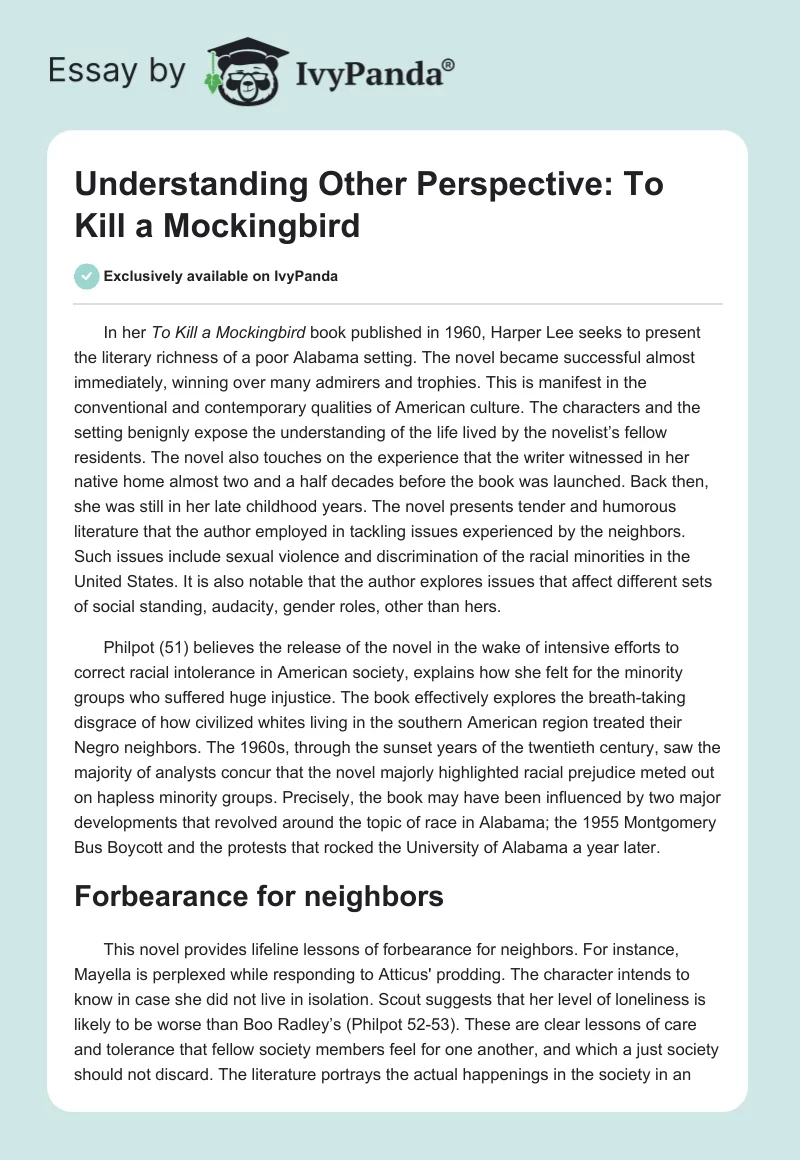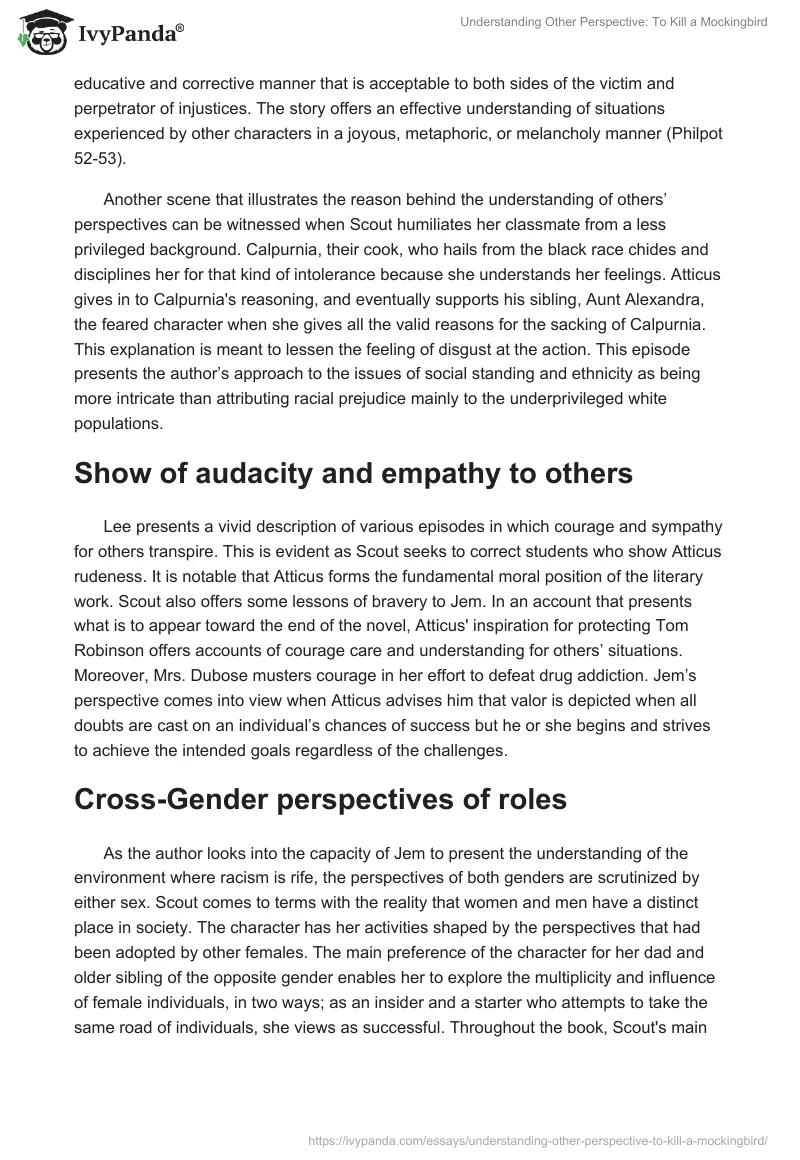In her To Kill a Mockingbird book published in 1960, Harper Lee seeks to present the literary richness of a poor Alabama setting. The novel became successful almost immediately, winning over many admirers and trophies. This is manifest in the conventional and contemporary qualities of American culture. The characters and the setting benignly expose the understanding of the life lived by the novelist’s fellow residents. The novel also touches on the experience that the writer witnessed in her native home almost two and a half decades before the book was launched. Back then, she was still in her late childhood years. The novel presents tender and humorous literature that the author employed in tackling issues experienced by the neighbors. Such issues include sexual violence and discrimination of the racial minorities in the United States. It is also notable that the author explores issues that affect different sets of social standing, audacity, gender roles, other than hers.
Philpot (51) believes the release of the novel in the wake of intensive efforts to correct racial intolerance in American society, explains how she felt for the minority groups who suffered huge injustice. The book effectively explores the breath-taking disgrace of how civilized whites living in the southern American region treated their Negro neighbors. The 1960s, through the sunset years of the twentieth century, saw the majority of analysts concur that the novel majorly highlighted racial prejudice meted out on hapless minority groups. Precisely, the book may have been influenced by two major developments that revolved around the topic of race in Alabama; the 1955 Montgomery Bus Boycott and the protests that rocked the University of Alabama a year later.
Forbearance for neighbors
This novel provides lifeline lessons of forbearance for neighbors. For instance, Mayella is perplexed while responding to Atticus’ prodding. The character intends to know in case she did not live in isolation. Scout suggests that her level of loneliness is likely to be worse than Boo Radley’s (Philpot 52-53). These are clear lessons of care and tolerance that fellow society members feel for one another, and which a just society should not discard. The literature portrays the actual happenings in the society in an educative and corrective manner that is acceptable to both sides of the victim and perpetrator of injustices. The story offers an effective understanding of situations experienced by other characters in a joyous, metaphoric, or melancholy manner (Philpot 52-53).
Another scene that illustrates the reason behind the understanding of others’ perspectives can be witnessed when Scout humiliates her classmate from a less privileged background. Calpurnia, their cook, who hails from the black race chides and disciplines her for that kind of intolerance because she understands her feelings. Atticus gives in to Calpurnia’s reasoning, and eventually supports his sibling, Aunt Alexandra, the feared character when she gives all the valid reasons for the sacking of Calpurnia. This explanation is meant to lessen the feeling of disgust at the action. This episode presents the author’s approach to the issues of social standing and ethnicity as being more intricate than attributing racial prejudice mainly to the underprivileged white populations.
Show of audacity and empathy to others
Lee presents a vivid description of various episodes in which courage and sympathy for others transpire. This is evident as Scout seeks to correct students who show Atticus rudeness. It is notable that Atticus forms the fundamental moral position of the literary work. Scout also offers some lessons of bravery to Jem. In an account that presents what is to appear toward the end of the novel, Atticus’ inspiration for protecting Tom Robinson offers accounts of courage care and understanding for others’ situations. Moreover, Mrs. Dubose musters courage in her effort to defeat drug addiction. Jem’s perspective comes into view when Atticus advises him that valor is depicted when all doubts are cast on an individual’s chances of success but he or she begins and strives to achieve the intended goals regardless of the challenges.
Cross-Gender perspectives of roles
As the author looks into the capacity of Jem to present the understanding of the environment where racism is rife, the perspectives of both genders are scrutinized by either sex. Scout comes to terms with the reality that women and men have a distinct place in society. The character has her activities shaped by the perspectives that had been adopted by other females. The main preference of the character for her dad and older sibling of the opposite gender enables her to explore the multiplicity and influence of female individuals, in two ways; as an insider and a starter who attempts to take the same road of individuals, she views as successful. Throughout the book, Scout’s main female characters whom she enjoys observing their perspectives are Calpurnia and Miss Maudie.
The perspective of others is also illustrated in the manner in which Scout observes her defile the innocence of a male rrelativeif only to conceal her own love for him. It is notable that the females at the frontline, who express their minds about Scout’s reluctance to stick more to the roles of the female gender also entail those that foster the most xenophobic and conventional perceptions against others. This is apparent as Mrs. Dubose disapproves of Scout’s refusal to put on a female outfit, and suggests that by so doing, she could be hurting the reputation of the household by her actions. The habit is also linked to a show of rudeness that the character targets at Atticus. This comes in the wake of the latter’s resolution to offer Tom Robinson formidable protection and contentment (Philpot 52-55).
Summary of the major points
Philpot (54) indicates that throughout the novel, the author illustrates how gender and social standing trigger chauvinism, repress the voices of reason and destroy the thinking of many Americans regarding bigotry and segregation. The author intelligently brings in the middle-class accounts of the story, a development that turns out to be a literary tool meant to attract every reader from all segments of society. This strategy augurs well with readers from all ethnicities and promotes the logic of eagerness to get informed. The ideology presented by Sharing Scout and Jem enables the reader to take part in issues pertaining to Mrs. Dubose, the archaic figure. The poorer Ewells and Cunninghams are also included into the mix, characters that, in spite of the prevailing class condition, the manner in which they understand the other characters is largely just. The opulent but highly disliked Mr. Dolphus Raymond, and Calpurnia are also caught in the business of observing others’ perspectives of survival and justice in society.
Conclusion
Generally, the novel offers remarkable understanding of human self-respect. Throughout the novel, the literature content shows the reasons why neighbors must respect, regardless of their social status or ethnicity. This is evident in how Atticus and Scout relate. The former offers advise that an individual may not have a clear insight of the behavior of another individual unless he or she understands his perception; not before one gets the inner feeling of the individual who is in question. This lesson is rich in sympathy, a key phenomenon of coexistence and neighborliness that the author has managed to present.
References
Philpot, Chelsey. The Long Life of a Mockingbird. Horn Book Magazine, 87.3 (2011): 51-55.


